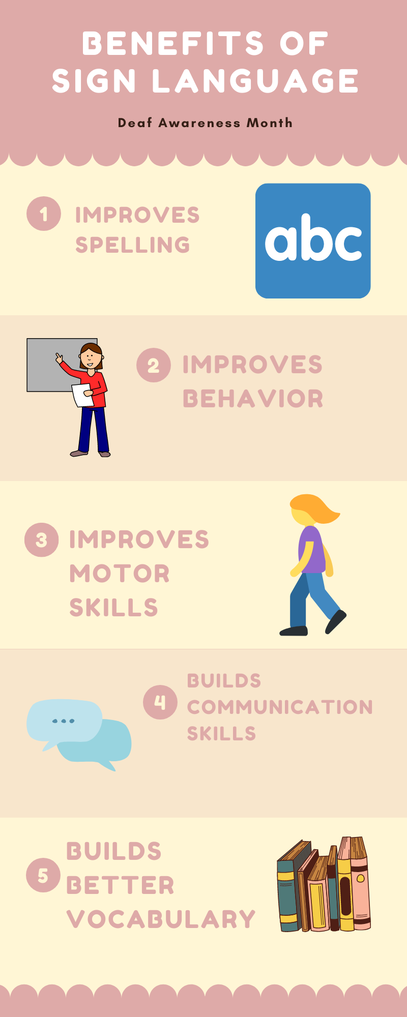|
I have been a teacher for the deaf and hard-of-hearing for 9 years now. A common question I got was if I would teach my child sign language. I always replied with a hearty, “Of course.” I wanted to pass my love for the visual language down to my offspring.
Nevertheless, I didn’t want to just teach my kids sign language because I happened to make a career out of it. There are many benefits to teaching children to sign from a young age. Hopefully, after reading these reasons, you’ll want to reap the same rewards from American Sign Language (ASL) as well.
1. Sign language is another way to make connections
Babies and toddlers are growing up in a very stimulating world. They have a lot coming at them every day. Bright lights. Loud sounds. Fast-paced action. Sign language is another way for them to make connections to language. When my son and I read a book, I point to a picture, say the word, and sign it. When I talk, I sign key words (MORE, PLEASE, MILK, WATER, etc). When we spell out words with his little magnet letters, I say and sign the word as well. When we are out and about and see everyday things, I point, say, and sign what it is. In all, he’s getting the spoken, written, picture or real-life representation, and ASL version of a word. Sometimes all at once. Sometimes not, but either way it’s one more way for a young child to begin forming word recognition and connections. Low-hanging fruit. 2. Sign language helps with communication Research has shown that too much screen time can cause speech delays in children, but sometimes screen time can be unavoidable in a technology driven world. Sign Language can help. Studies have found that sign language taught at an early age can help progress speech development faster. In addition, sign language aids in easing frustrations. Oftentimes, toddlers don’t have the words to produce what they want, but they are able to sign what they want. Does it eliminate all whining and tantrums? No, but sign language prevents unnecessary prolonged crying. For example, instead of whining and leaving my guessing what he wants, my son can sign when he wants to drink milk, eat food, go to sleep, get more to eat, and be all done eating. He brings me a toy he wants opened or turned on by signing please. On the other hand, we can sign when something is “hot, no touch,” and he can repeat back by saying, “hot” and backing away. He also can find his toy animals when we sign what they are. We can see that he is reasoning in his mind that he understands what we just signed, and he is trying to put the pieces again. Then, the lightbulb goes off, and he finds the object. Overall, ASL combined with speech touches upon visual, auditory, and kinesthetic processing and helps store more pathways in the brain; therefore, memory becomes stronger. Again, another easy way to help in your children’s development. 3. Sign language can be discreet. All parents have had those moments where we are out in public and our child is causing a disturbance. We hiss under our breaths, “Stop it,” but our child can’t hear us. We want more than anything for the earth to swallow us whole. However, with sign language, I can sign STOP, NO, WAIT, HOLD without raising my voice and attracting all kinds of unwanted attention. It doesn’t work every time, but it is setting my son up for success in that I am teaching my son another way to control his behavior. On other occasions, I can sign something to my son without causing a break in the conversation. At dinner, and I notice my son needs to take a drink? I sign WATER. My son wants me to do something? I can casually rub my upper chest for PLEASE to let him know that he needs to say that first. Hopefully, in the future he can let me know when he has to go to the bathroom without shouting, “Poo poo or pee pee,” in a setting like church (although that would be funny). However, sign language lets you have those conversations you don’t want the world knowing. 4. Sign language is fun. Lastly, sign language is just fun. Little kids love hand movements and gestures, and sign language is exactly that. With it, parents and children can sign songs, nursery rhymes, and books. ASL is another fun element added on top of learning experiences. YouTube has tons of videos parents can search and what better way to spend some time with the kids. Sign language is another resource to have in a parent’s toolkit. I can see the light in my son’s eyes when he makes a connection. I can see his frustrations melt away when I quickly recognize what he is trying to communicate. I can see my shoulders visibly relax when I avoid a public meltdown with just one sign. I see the joy he gets when I make silly faces and songs. I can see him learning and growing. And that’s why I am teaching him sign language. Resources for Parents Elise Tate, Mommy Influencer, creator of SignMeUp, and wife of NFL player Golden Tate, has a great starter sign resource for all parents, teachers, and caregivers wishing to teach their children or students sign language. Her love of sign language started out as a necessity and soon turned into a passion project. After hearing the statistics that 90% of deaf children are born to parents who can hear, but up to 88% of those parents will never learn how to sign, Elise knew that she had to get her book and resources into homes and classrooms. SignMeUp is a book/resources designed for parents to teach their children sign language. She has plans to publish a whole series of sign language books and posters as well. Her dream is to expand the books to be in all schools, doctor offices, and hospitals. So why SignMeUp? 1. SignMeUp is easy to use. 2. SignMeUp is great for non-signers. 3. SignMeUp is a great resource. 4. SignMeUp is aesthetically pleasing and durable. 5. SignMeUp is diverse.
0 Comments
Leave a Reply. |
Categories
All
|
Proudly powered by Weebly




 RSS Feed
RSS Feed